
- Homepage
- Binding
- 1 / 2 Leather (2)
- 3 / 4 Leather (2)
- Brochure / Pamphlet (4)
- Cloth (87)
- Disbound (3)
- Fine Binding (52)
- Hard Back (2)
- Hard Cover (4)
- Hardback (6)
- Hardcover (893)
- Hardcover Sheepskin (2)
- Hardcover W / Jacket (5)
- Hardcovers (2)
- Leather (259)
- Original Blue Cloth (2)
- Quarter Leather (3)
- Softcover (3)
- Softcover, Wraps (42)
- ... (3553)
- Language
- Region
- Subject
- American History (7)
- Americana (79)
- Art & Photography (7)
- Bible (12)
- Children's (4)
- Civil War (60)
- Exploration & Travel (5)
- Fashion & Costumes (4)
- Figures & Portraits (19)
- Historic & Vintage (10)
- History (255)
- Illustrated (7)
- Literature & Fiction (37)
- Men, Civil War (8)
- Military (20)
- Military & Political (131)
- Military & War (644)
- New York (4)
- Reference (19)
- Science & Medicine (8)
- ... (3586)
- Topic
- American (us) (22)
- American Civil War (14)
- American History (4)
- Atlases (4)
- Bible (5)
- Christianity, Bibles (97)
- Christmas (4)
- Civil War (50)
- Civil War (1861-65) (894)
- Classics (6)
- Essays & Speeches (3)
- Grant (3)
- Historical (34)
- Literature (5)
- Military (24)
- Plantation Life (6)
- Religion (6)
- The Civil War (4)
- U.s. Grant (13)
- United States (30)
- ... (3698)
- Year Printed
1863 Harper's Weekly Bound full year Civil War, Lincoln, Thomas Nast, etc
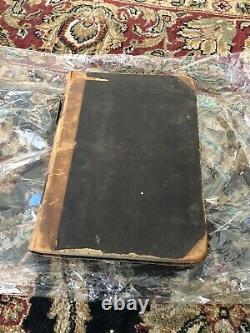

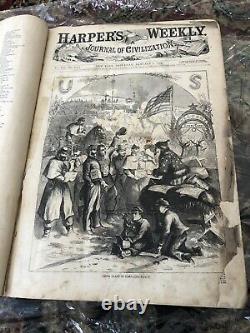
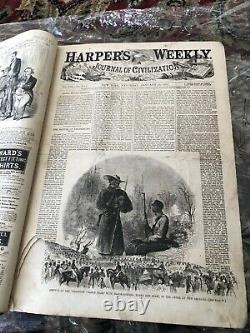
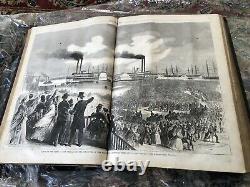
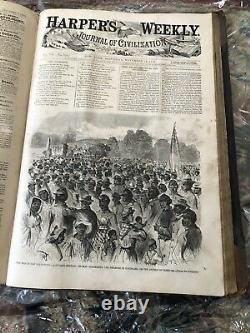
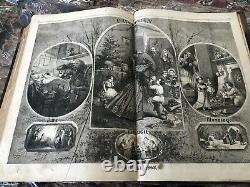

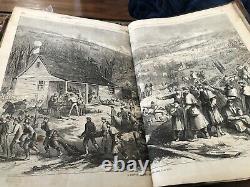


Please note I will be listing a group of books and prints to finish off the sale of my collection. Most of the volumes contain collectible prints, both engravings and lithographs. Most of the volumes are very difficult. HARPER'S WEEKLY A JOURNAL OF CIVILIZATION Jan-Dec 1863. Artist: Harper's used multiple famous artists to illustrate the volumes: Thomas Nast, Livingston Hopkins, Alfred & William Waugh, Theodore Davis, Henry Mosler, Granville Perkins, Thomas Worth, Frederick Remington as well as Winslow Homer.
Description: complete volume Jan through December 1863, heavily illustrated as is typical of Harpers, many illustrations of Civil War scenes and famous figures. Condition: see photos for details, appears to have been heavily used.Details items being offered (prints and books). Over the years, the collection has expanded and contracted depending on the collectable opportunities. At one point the collection was in excess of 3,000 prints, representing one of the larger private collections of lithographs in the United States.
Collection management has reduced the sheer size of the collection while retaining many uncommon images. The major focus of the collection is lithographs with an emphasis on work by Currier & Ives.The collection also contains many other notable lithographers whose work is considered historically important, unique, or valuable to the depiction of a sense of time. It is important to note that Currier & Ives considered themselves to be print makers to the people and their works were priced so that the common man could enjoy them.
Perhaps this is the reason that so many have deteriorated over the years. As you will see some are in need of conservation however I have decided to sell the lithos. Records do not indicate a sale of this variety of large folio Currier lithographs in at least 75 years. Included are lithographs of the inventor of lithography, Alois Senefelder (of Germany where there is a ready supply of fine-grained limestone), as well as the first publisher of the first lithographs issued in America, Bass Otis, along with Otis first publication of the method of stone lithography.The collection contains a number of prints that are unrecorded, and some for which there may be no other copies outside of museums. With a few where there is no known extant example. Included in the Collection are hundreds of lithographs by John Pendleton, Peter Duval, Nathaniel Currier, Currier & Ives, Charles Currier, the Kellogg brothers, Napoleon Sarony, Haskell & Allen, Thomas Kelly, James Baillie, and many others.
In addition, there are a number of sheet music titles as sheet music was one of the earlier and steadier forms of work available to the lithographers. Sheet music constituted an important part of the history of lithographic print production in the United States. History of Currier & Ives.Nathaniel Currier was apprenticed in 1828, at the age of 15, to the Boston printing shop of William & John Pendleton. He was taught lithography there by the chief printer, a man named Dubois. In 1833, he left the Pendletons operation and move to Philadelphia to work with M E D Brown. In 1834, he moved to New York City to rejoin John Pendleton, where he formed a partnership with Stodart and bought out John Pendleton.
The firm was named Currier & Stodart. This firm performed commercial orders including sheet music. By 1835, they had dissolved their partnership, and Currier started his own business N. Currier, Lithographer at 1 Wall Street.
Currier published prints with H W Hewitt of newsworthy events such as the death of President Harrison in 1841, and The Ruins of the Planters Hotel, New Orleans, which is believed to be his first disaster print. Currier gained fame with the disaster print Awful Conflagration of the Steamboat Lexington published in the New York Sun.
This same print was also issued separately and was mimicked by D. The Collection contains several of these extraordinary images. In 1852, Currier hired James Ives (the brother-in-law of Charles Currier) as the office manager. Ives was a self-taught artist..
In 1857, Ives was made a partner, and from then on, the imprints were Currier & Ives. In 1880, Nathaniel Currier retired and turned the business over to his son, Edward. James Ives remained with the firm until his death in 1895. James Ives son, Chauncey, replaced his father as partner.
Addresses and Approximate Dates: useful for dating the undated prints. Stodart & Currier 137 Broadway NY 1834-35. Currier 1 Wall Street NY 1835-36. Currier 148 Nassau St NY 1836-37. Currier 152 Nassau St Cor. Currier 2 Spruce St NY 1838-56. C&I 152 Nassau St NY 1857-72. C&I 125 Nassau St NY 1872-74.C&I 123 Nassau St NY 1874-77. C&I 115 Nassau St NY 1877-94. C&I 108 Fulton St NY 1894-96.
Of note, Currier utilized 2 floors of 33 Spruce Street in New York City from the year 1866 onward, but rarely used that address on the prints. Prints have been found, however, dating far before the year 1866 with the 33 Spruce Street address. It is suspected that the location was used many years earlier by Charles Currier and the colorists working for Nathaniel Currier.
Lithographers and Artists included in the collection. There were other lithographers competing with Currier & Ives, although none were ever quite as successful as Currier & Ives with the sale of prints directly to the public. Generally, the competitors producing work for direct public sale, produced artwork that was somewhat more primitive using paper stock of a lesser grade. There are some notable exceptions such as John T. Bowen, who produced the McKenney & Hall lithographs as well as the small folio Audubon lithographs. Some of the competitors either had trained with or had worked for Currier, or Currier had worked with them, at one time or another. The notable lithographers are as follows. An early American artist and portrait painter, Bass Otis, produced the first lithograph in the United States in 1819 in Philadelphia. There is some debate about the title of the first lithograph as there are reported different versions of the July 1819 Analectic Magazine. The version in this Collection, along with the article describing the lithographic process is believed to be the first. His early studies of painting were with Gilbert Stuart and John Wesley Jarvis in Boston. From there, he moved to Philadelphia, where he painted over 300 portraits of the famous people of the day. Charles Currier was Nathaniels younger brother, and a brother-in-law of James Ives.He worked with Currier & Ives, and also ran his own business of lithography at 33 Spruce St. His work was predominately of a commercial nature creating lithographs for books and periodicals.
Charles is most famous for inventing an improved lithographic crayon which he trademarked as Crayola Crayons. John & William Pendleton the Senseis that trained Nathaniel Currier.
Although not much of their work becomes available today, it appears that they were active producers of bookplates, portraits, landscape views, and sheet music covers. Famously, they worked with the artists Rembrandt Peale and Charles Wilson Peale, then later with Abel Bowen, the famous engraver. Most importantly, they gave Nathaniel Currier his first job in printing and trained him in lithography.They also trained or hired many early artists including Nathaniel. Currier, John H Bufford, Nutting Fitz, Henry Lane among others. Most but not all of the work of the firm was commercial in nature including bookplates and sheet music.
There are also many examples of his stand alone prints. John Henry Bufford was the son of a sign painter and gilder. The company went through several iterations and name changes until about 1865. Which lasted from 1844 to 1851. He continued to work in the lithography and publishing business for the remainder of his life. In 1865, his sons, Frank and Henry John became partners in Bufford & Sons or J. After his death, they continued the family business as Bufford Brothers and as Bufford Sons Engraving & Lithographing Company until 1911. Some of their large folios of ships are remarkable. Bowen came to the United States from England in 1834 at the age of 33. He worked as a colorist in New York City, and then moved to Philadelphia in 1838. In Philadelphia, he began producing the famous History of The Indian Tribes for McKenney & Hall. He also took over production of the Views of Philadelphia from Wild & Chevalier.He is most famous for his bookplates, but he did occasionally publish individual plates for sale. He partnered with John Cassin to produce Illustrations of the Birds of California. Duval trained in Europe as a lithographer and moved to Philadelphia in 1831 to work for Childs & Inman lithography. He started his own firm in 1837 where he remained in business until he retired in 1869. Most of his work was commercial jobs in nature, such as bookplate lithographs and engravings and advertising.
His lithographs are quite rare today. Doolittle was an early engraver and silversmith known as the Revere of Connecticut.
He famously created the copperplate engravings of the Battles of Lexington and Concord. He produced portraits, maps and engravings for books. The firm retained his name until 1842, although after 1836 the work was done by his brothers and other employees. In 1842, the firm was formally taken over by his younger brothers E.
The firm was in Hartford, Connecticut. The Daniel Kellogg lithographs are generally of much higher quality and printed on a finer textured paper quality than any of the other lithographers of the time including Currier. These are all from the 1830s. Most if not all of Daniel Kelloggs work was designed for sale to the public, and he appears to have been a more talented artist than his brothers. The Kellogg brothers in all the various iterations of the firm were very prolific producers of lithographs for sale to the public, probably only secondary to Currier & Ives. Edmund Burke & Elijah Chapman Kellogg were the younger brothers of D. Established in 1842, they operated under this name until 1848, then became Kellogg & Comstock through 1850. The brothers resumed their partnership in 1855, and continued until the firm became Kellogg & Bulkeley in 1867.In 1848, the Kelloggs were joined by John C. Comstock, but the association was dissolved in 1850.
This was the succeeding firm after the E. Kellogg years, and was formed in 1867. Haskell & Allen was a famous lithography firm out of Boston with some truly remarkable prints, equally collectible as compared to Currier. This Boston based publisher of lithographs seems to have issued more large folio images than their small counterparts.In 1873, they moved to 61 Hanover St in Boston where they prospered for a few years. Haskell and Allens most memorable productions were their horse prints. They went bankrupt in 1878. Started by the famous photographer and artist, Napoleon Sarony. In the early years of Curriers business, Napoleon Sarony did some work for Currier, including the Old Best 50 Noahs Ark.
This firm produced lithographs for the famous Pacific Rail Road Survey of the mid-1850s along with many other US government surveys and explorations including Perrys famous Japan trip in 1857. Napoleon Sarony (18211896) was born in Quebec and trained under several lithography firms including Currier & Ives and H. Sarony was also known for his successful experiments in early photography, developing his own cabinet-sized camera. In 1846, he partnered with another former apprentice of Nathaniel Currier, Henry B. Major, and the duo created lithography firm of Sarony & Major. Knapp joined the firm in 1857. Sarony, Major & Knapp earned a solid reputation for lithography, and the company was especially known for its fine art chromolithography.Sarony departed the business in the mid-1860s to pursue photography fulltime, and by the 1870s, the firm shifted its production from decorative prints to the more profitable field of advertising. It expanded to become the conglomerate known as the American Lithographic Company, which produced calendars, advertising cards, and posters.
In 1930, it was bought out by Consolidated Graphics. James Baillie was active in New York from 1838 to 1855.
Baillie started as a framer in 1838, and then became an artist and lithographer in 1843 or 1844. He discovered how to color lithographs while working as an independent contractor for Currier & Ives in the mid 1840s. As a prolific lithographer and colorist for Currier & Ives, his prints were extremely popular with a wide distribution. Baillie spent his later years concentrating on painting instead of lithography. Many of his prints appear to be the knockoffs of Currier works.
It is unclear if Currier might have shared some of the lithographic stones with him. Thomas Kelly, of New York City, was one of the more successful publishers of the period, creating archetypal and idyllic views of all areas of life in America. Kelly's work is distinctive for strong coloring and vivid forthright compositions.Not too much detail is known about Kelly, but he worked at least in the 1850s in New York City. His artwork is often more primitive than Currier & Ives, but did produce a few fine pieces to be found in the collection. William Endicott (Endicott & Co).
Known as one of the leading lithography firms of the mid-19th Century, Endicott and Company was formed in 1852 as the successor to William Endicott and Company following the death of George Endicott in 1848 and William Endicott in 1852. The original partners of Endicott and Company were Sarah Endicott (William Endicotts widow) and Charles Mills. However, in 1853 the senior partner was Sarah and Williams son Frances Endicott.
The company often did work for Currier and Ives, and employed the well-known artist Charles Parsons. In 1856, the company was awarded a diploma for the best specimen of lithography at the 28th Annual Fair of the American Institute. Sinclair trained in lithography in his native Scotland before migrating to New York and then Philadelphia in 1830. He worked for John Collins before acquiring the firm in 1840.
He produced all types of commercial lithographs including the bookplates for a number of US Governmental surveys and explorations. He also produced sheet music lithographs, advertisements, portraits, landscape views and maps. He was a direct competitor of Peter Duval in the production of colored lithographs in Philadelphia. Sinclair was an early producer of chromolithographs and died in 1881.Originally formed as Firth & Hall, it was renamed in 1847 when Hall departed. The company with many iterations was famous for its production of sheet music often using many of the lithographers noted above for its illustrations on the front of the sheet music.
Items of this work are included in the Collection as sheet music lithography, an important source of commercial revenue for many of the lithographers. Artists with Lithographs by Currier. Over the years, the firm employed or worked with many artists, and many artists used Currier as an outlet for their freelance work. Some of the more famous ones are listed below.
There are the noteworthy examples of most in the Collection. Notably recall that Nathaniel Currier, Charles Currier and James Ives were artists in their own rights. Outside artists might be employed to do a painting or sketch, and might or might not be employed to recreate the image on the stone as the lithographer. Note that Charles Parsons, who was the lead artist for Harper's Weekly, worked with Thomas Worth at both Currier's shop as well as Harper's.
Originally Currier and subsequently Currier & Ives used a quality of paper that was better than some of their peers, with what appears to be a higher rag content of cotton fiber. As several collectors have noted, during the Civil War, Currier & Ives frequently used a grade of paper of much lower quality as cotton linters were scarce, and that is one of the reasons it is so difficult to obtain Civil War lithographs in decent condition. This does not refer to the size of the paper on which the lithograph was printed, but rather the image size itself. Very Small: up to about 7 by 9. Small: approximately 8.8 by 12.8. Medium: approximately 9 by 14 to 14 by 20. Large: anything over 14 by 20. Note that Gale and Conningham occasionally have differences of opinion on what is a small, a medium, or even a large folio lithograph.These sizes also apply to the other makers of lithographs. Sorting out small versus medium on the vignettes is virtually impossible, and many of the determinations by both Gale and Conningham appear to be arbitrary in nature. George Cohenour, Currier & Ives Lithographs Value Guide, it is out of print and is not always easy to find. The prices are out of date, as in 2001, but the list is more complete than Conningham. In my view, they are best reference books.
Frederic Conningham, Currier & Ives An Illustrated Check List , this particular one and the Gale Research are the core of any set of Currier & Ives books. Harry Peters, America On Stone.
Harry Peters, Currier & Ives, Printmakers to the American People. American Historical Print Collectors Society publication: Imprint.
Jane Cooper Bland, Currier & Ives A Manual for Collectors. For the next year or two I plan to list 10+ lithographs per week so I can thin down the mass of prints stored in cabinets. I will try to answer any and all questions posed to me. Generally, I start the lithographs off at a low price, however, there will be a select few that are not in the low-price category. If you notice an error just let me know and I will fix it promptly or remove the litho. You may return this lithograph if you are dissatisfied with the accuracy of my description, or if I failed to disclose pertinent information in either: the description, details, pictures or answers to queries.Thanks for looking and good luck, I hope you are successful in your collecting! The item "1863 Harper's Weekly Bound full year Civil War, Lincoln, Thomas Nast, etc" is in sale since Friday, December 3, 2021.
This item is in the category "Books & Magazines\Antiquarian & Collectible". The seller is "jimgacb" and is located in Franklin, Tennessee. This item can be shipped to United States.
- Year Printed: 1862
- Modified Item: No
- Country/Region of Manufacture: United States
- Topic: American History
- Binding: Hardcover
- Region: United States
- Illustrator: Thomas Nast
- Author: Harper's
- Subject: Americana
- Personalized: No
- Original/Facsimile: Original
- Language: English
- Character Family: Politicians
- Signed: No
- Publisher: Harpers
- Place of Publication: NY
- Special Attributes: 1st Edition

